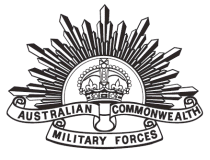
| Regimental number | 726 |
| Place of birth | Hay, New South Wales |
| Religion | Church of England |
| Occupation | Tramwayman |
| Address | 243 New South Head Road, Paddington, Sydney, New South Wales |
| Marital status | Single |
| Age at embarkation | 26 |
| Height | 5' 8" |
| Weight | 160 lbs |
| Next of kin | Father, William Parr, Finley, New South Wales |
| Previous military service | Nil |
| Enlistment date | |
| Place of enlistment | Randwick, New South Wales |
| Rank on enlistment | Sergeant |
| Unit name | 1st Battalion, G Company |
| AWM Embarkation Roll number | 23/18/1 |
| Embarkation details | Unit embarked from Sydney, New South Wales, on board Transport A19 Afric on |
| Rank from Nominal Roll | Private |
| Unit from Nominal Roll | Australian Army Medical Corps Details |
| Fate | Killed in Action |
| Place of burial | No known grave |
| Commemoration details | Australian National Memorial, Villers-Bretonneux, France Villers-Bretonneux is a village about 15 km east of Amiens. The Memorial stands on the high ground ('Hill 104') behind the Villers-Bretonneux Military Cemetery, Fouilloy, which is about 2 km north of Villers-Bretonneux on the east side of the road to Fouilloy. The Australian National Memorial, Villers-Bretonneux is approached through the Military Cemetery, at the end of which is an open grass lawn which leads into a three-sided court. The two pavilions on the left and right are linked by the north and south walls to the back (east) wall, from which rises the focal point of the Memorial, a 105 foot tall tower, of fine ashlar. A staircase leads to an observation platform, 64 feet above the ground, from which further staircases lead to an observation room. This room contains a circular stone tablet with bronze pointers indicating the Somme villages whose names have become synonymous with battles of the Great War; other battle fields in France and Belgium in which Australians fought; and far beyond, Gallipoli and Canberra. On the three walls, which are faced with Portland stone, are the names of 10,885 Australians who were killed in France and who have no known grave. The 'blocking course' above them bears the names of the Australian Battle Honours. After the war an appeal in Australia raised £22,700, of which £12,500 came from Victorian school children, with the request that the majority of the funds be used to build a new school in Villers-Bretonneux. The boys' school opened in May 1927, and contains an inscription stating that the school was the gift of Victorian schoolchildren, twelve hundred of whose fathers are buried in the Villers-Bretonneux cemetery, with the names of many more recorded on the Memorial. Villers-Bretonneux is now twinned with Robinvale, Victoria, which has in its main square a memorial to the links between the two towns. |
| Panel number, Roll of Honour, Australian War Memorial | 30 |
| Other details |
War service: Egypt, Gallipoli, Western Front Embarked Alexandria to join the Mediterranean Expeditionary Force (Gallipoli Campaign), 5 April 1915. Wounded in action, 20 May 1915 (bullet wound, fingers and arm); admitted to No 1 Australian General Hospital, Heliopolis, 28 May 1915; transferred to 21st General Hospital, Alexandria, 13 August 1915; discharged to Cairo, 1 October 1915. Admitted to No 2 Australian Convalescent Depot, Heliopolis, 1 October 1915 (diarrhoea); discharged to duty, 12 November 1915. Transferred to 'A' Details, 1st Training Bn, Zeitoun, for light duties, 12 November 1915. Attached for duty, Base Medical Stores, Heliopolis, 18 November 1915. Embarked Alexandria for England, 3 August 1916. Proceeded overseas to France, 16 September 1916; rejoined 1st Bn, in the field, 1 October 1916. Killed in action, 5 November 1916. Statement, Red Cross File No 2090804N, 5478 Pte James WARNE, D Company, 1st Bn (patient, 3rd Southern General Hospital, Cowley Section, Oxford, England), 27 April 1917: 'I know that George Parr (1. D.) was reported as missing after the engagement at Kers [marginal notation: Flers?], on Nov. 5th. I went all through the attack that night. we had to come back as we were repulsed. In February after we had taken the ground, on the evacuation of the enemy a party of about 30 of us went out to bury our dead. George Parr was one of those who was found. He was buried out in the open, where he fell. There was a cross put up with his name on. I saw his disc.' Second statement by WARNE (patient, 3rd Auxiliary Hospital, Dartford), 29 May 1917: 'I helped to bury the remains of George Parr in a shell hole at Flers, in the 1st week of Feb. 1917 and put up a cross over his grave. I knew him formerly very well and am certain as to his identity, from the colour of the hair, general appearance of the body and particularly from Machine Gun Badge, which he had shifted from left arm to right, some time before, owing to some joke we had as to the left arm being unlucky. He and I had been together for two months at Perham Downs and on [the] Somme. I reported this at Oxford 3rd S. Gen. Hpl. to B.R.C.' Third statement, 1590 Pte R.E. BOYD (patient, 2nd London General Hospital, Southall, England), 25 October 1917: 'About 2 months ago I had a letter from home telling me that his people had heard from him directly stating that he is a prisoner of war in Germany. They did not mention what Camp.' Sydney office contacted sister, who said that the family had not received any such information. Medals: 1914-15 Star, British War Medal, Victory Medal |
| Sources | NAA: B2455, PARR George Joseph
Red Cross File No 2090804N |